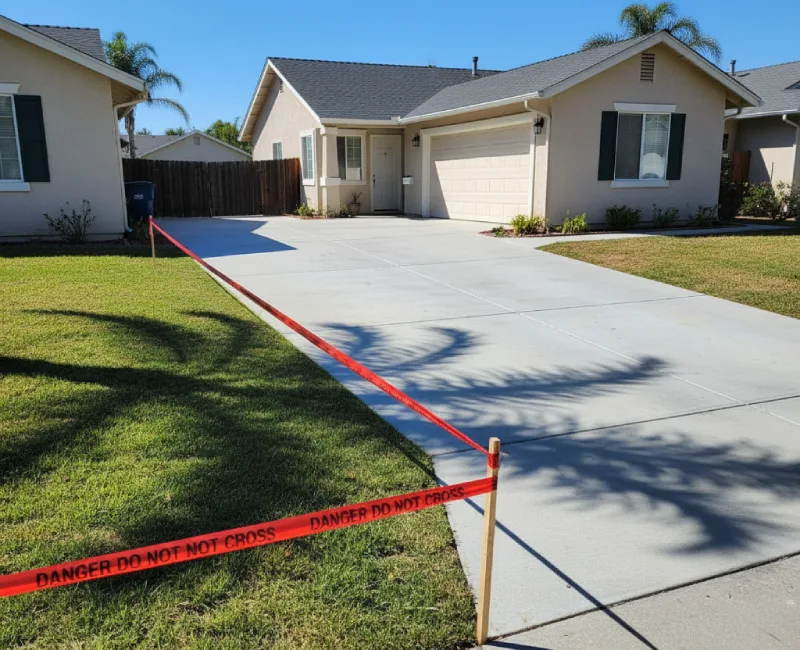Dealing with property encroachment in California can be stressful. Maybe a neighbor’s fence crosses onto your lot, or you discover a shed or driveway built past the boundary line. Encroachments are common in dense neighborhoods and older properties where survey records aren’t always precise.
So, how do you handle property encroachment? The short answer: confirm the boundary with a licensed surveyor, document everything, talk to your neighbor, and try to resolve it through agreement. If that fails, mediation or legal action may be necessary. And if the hassle feels overwhelming, Osborne Homes can buy your house as-is, even with encroachment issues, so you don’t have to deal with it at all.
Here’s a step-by-step guide to handling property encroachment in California.
Table of Contents:
- Step 1: Confirm the Encroachment
- Step 2: Talk to Your Neighbor First
- Step 3: Put Agreements in Writing
- Step 4: Explore Mediation or Legal Help
- Step 5: Know the California Laws & Time Limits
- What if You’re the One Encroaching?
- Can You Sell a Property With an Encroachment?
- Risks of Ignoring an Encroachment
- FAQs About Property Encroachment in California

Step 1: Confirm the Encroachment
Before diving into surveys and documents, start by confirming that an encroachment actually exists. Many disputes arise from unclear property lines or assumptions. Taking the time to verify boundaries prevents unnecessary conflict and ensures you have evidence to support your case.
Hire a Licensed Surveyor
The first step is to get clarity. A professional land surveyor can precisely mark your property lines and determine whether a fence, structure, or landscaping truly crosses into your lot.
Gather Documentation
Collect copies of your deed, the neighbor’s deed if available, and any property maps. Take clear, dated photos of the encroachment so you have visual proof in case you need it later.
Examples of Encroachment
Encroachments come in many forms, such as:
- A fence post or wall that extends over the property line
- A driveway or walkway that crosses into your yard
- A shed, garage, or pool built too close to (or over) the boundary
- Overhanging structures like balconies or roof extensions
Encroachment vs. Easement: What’s the Difference?
The distinction between encroachments and easements matters because it determines your legal rights and the steps you’ll need to take to resolve the situation.
Encroachment: Unauthorized use of your land, often unintentional.
- A neighbor’s fence built a few feet over your property line
- A shed or garage that was constructed too close and crosses the boundary
- Tree branches or landscaping that extends onto your yard
- A driveway addition that wasn’t properly surveyed and encroaches on your lot
Easement: A legal right, often recorded, allowing someone to use a portion of your property.
- A shared driveway agreement documented in both property deeds
- Utility company access rights for power lines or water pipes
- A recorded pathway allowing a neighbor to reach their backyard
- Beach or water access rights granted through official agreements
Step 2: Talk to Your Neighbor First
Once you’ve confirmed the encroachment, the next step is to approach your neighbor. Most issues can be solved faster through direct communication. A calm, evidence-backed conversation often prevents the need for costly legal disputes.
Why Start With a Conversation
Many neighbors don’t even realize their project crossed the line. A respectful, calm conversation can resolve the issue before lawyers get involved. In these early talks, it’s helpful to understand whether you’re dealing with a true encroachment or something that could become a legal easement.
If the issue involves a fence, keep in mind that under California’s Good Neighbor Fence Act (Civil Code § 841), adjoining property owners share fence responsibility and must give 30 days’ notice before repairs or replacement.
Informal Solutions You Can Try
You may agree to:
- Remove or relocate the encroaching structure
- Grant a simple easement allowing continued use
- Sell a portion of the land to your neighbor

Step 3: Put Agreements in Writing
If you and your neighbor agree on a resolution, document it. Verbal promises can be forgotten or challenged later, but a written agreement protects both sides and ensures the arrangement holds up in the future.
What to Include in a Sample Encroachment Letter to Neighbor
If a verbal discussion isn’t enough, draft a letter that:
- Identifies the property and encroachment
- States your request (remove, relocate, or negotiate)
- Sets a reasonable deadline for response
Recording an Easement or Agreement
If you reach a deal, make it official. A recorded easement, land sale, or written settlement ensures the resolution is legally binding and enforceable for future buyers.
Step 4: Explore Mediation or Legal Help
When conversations and letters don’t solve the problem, it may be time to bring in outside help. Mediation offers a middle ground, while legal action ensures your rights are protected when no agreement can be reached.
When Mediation Makes Sense
A neutral mediator can help both sides reach an agreement without a court battle. Mediation is faster and less expensive than a lawsuit.
When to Consult an Attorney
If your neighbor refuses to cooperate, a California real estate attorney can guide you through your options and protect your rights. Just as with handling squatter situations, having legal guidance can protect your property rights.
Legal Remedies in California
- Injunction: A court order requiring removal of the encroachment
- Quiet Title Action: Lawsuit to clarify ownership of the land
- Trespass/Ejectment: Claims to seek damages or force removal
Step 5: Know the California Laws & Time Limits
California has specific rules about property disputes, and knowing them is essential. Missing deadlines or ignoring issues can mean losing your rights altogether. Here are the main legal timeframes and terms you need to understand.
Trespass Claims Statute of Limitations
You typically have 3 years from the time you discovered the encroachment to file a trespass lawsuit. California gives you three years to sue for trespass to real property under Code of Civil Procedure Section 338(b).
Prescriptive Easements (5-Year Rule)
If someone uses your property openly and continuously for 5 years, they may gain a legal right to keep using it.
Adverse Possession in California
In rare cases, if your neighbor uses your land for 5 years and pays property taxes on it, they may claim ownership.
Fence Encroachment Laws
Don’t take matters into your own hands. You can’t just tear down a neighbor’s fence; you need a proper legal process to avoid liability. Remember that under California’s Good Neighbor Fence Act (Civil Code § 841), adjoining property owners share fence responsibility and must give 30 days’ notice before repairs or replacement.

What if You’re the One Encroaching?
Sometimes, the encroachment is on the other foot. If you discover that your fence, shed, or driveway crosses onto your neighbor’s land, you’ll want to act quickly. Taking responsibility now can prevent a small mistake from turning into a lawsuit later.
- Minor Fixes: If it’s a small issue like a fence or landscaping, simply move it back onto your property.
- Negotiating With Your Neighbor: For larger structures (like a garage addition), you may need to negotiate an easement or even purchase the small strip of land.
- Buying or Leasing the Affected Land: Some neighbors will agree to sell you the portion in question or grant a long-term lease.
Can You Sell a Property With an Encroachment?
Yes, you can sell, but expect challenges. Buyers are often hesitant about unresolved property disputes, and lenders may require resolution before closing. Knowing your options helps you set realistic expectations when listing your home.
- Selling Traditionally: When selling, you’ll need to disclose the issue. Some buyers may still move forward, but expect negotiations. California law requires most sellers to complete a Transfer Disclosure Statement (Civil Code § 1102), disclosing any known encroachments or boundary issues. Like selling a house with title issues, encroachments require full disclosure to potential buyers.
- Buyer Concerns and Lower Offers: Encroachments can scare buyers off or lead them to offer less, since they may face legal costs.
- Osborne Homes’ Cash Option: If you don’t want to risk delays or low offers, Osborne Homes can buy your house for cash, encroachment and all. We’ll handle the problem after closing.
Risks of Ignoring an Encroachment
Choosing to “wait and see” is usually the worst option. Encroachments don’t go away on their own, and the longer you ignore them, the more complicated they become.
- Loss of Property Rights: Wait too long, and your neighbor may gain rights through a prescriptive easement or adverse possession.
- Decreased Property Value: Homes with boundary disputes are harder to sell and often fetch lower prices. There are many reasons to sell your house before property issues compound further.
- Liability Risks: If someone gets hurt on the encroached portion of land, you could be held responsible.
FAQs About Property Encroachment in California
What are encroachments on property?
An encroachment is when a structure or improvement crosses onto someone else’s land without permission, like fences, driveways, or sheds.
How do I file a property encroachment in California?
Start by confirming the boundary with a survey. Then, consult a real estate attorney to file a trespass or quiet title action if needed.
Can I remove a fence encroaching on my property?
Not on your own. Document the issue, talk to your neighbor, and seek legal guidance. Removing it yourself can lead to liability.
What’s the difference between encroachment and easement?
Encroachments are unauthorized uses of land. Easements are legal, recorded rights to use part of someone else’s property.
What is the California Encroachment Statute of Limitations?
The statute of limitations for encroachment in California sets a deadline for property owners to take legal action against unauthorized use of their land. Missing this window could limit your ability to reclaim your property.
How can I discover encroachments before buying a house?
Review the property survey, compare it to physical boundaries, and walk the property with your agent to spot any discrepancies.
Can you sell a property with an encroachment?
Yes, but buyers may hesitate or offer less. Osborne Homes can purchase your home as-is, with no encroachment fixes required.
Osborne Homes: A Hassle-Free Solution to Encroachment Problems
At Osborne Homes, we know property disputes can be overwhelming. That’s why we make it simple: we’ll buy your house for cash, even if it has encroachment issues. No repairs, no court battles, no waiting. We close quickly so you can move on with peace of mind.
Selling your house to an investor removes the burden from your shoulders entirely. We handle everything, and once the sale is final, we’ll do the work to correct the encroachment. Maybe the best part of all of this is that since we pay all cash, we close FAST.
Ready to sell your California home with an encroachment? Contact Osborne Homes today.

